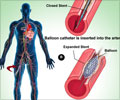- Persons with with type 2 (non-insulin dependent) diabetes have an increased risk of developing heart disease.
- Central artery stiffness is an important determinant of plaque build-up (atherosclerosis) in blood vessels, which could consequently increase the heart attack risk.
- Fasting as well as post-prandial blood glucose levels in type 2 diabetes influence development of central artery stiffness and therefore heart attack risk.
The current study aimed to determine the alterations in central artery stiffness in type 2 diabetes over a 5 year follow-up period. The independent influences of both fasting and post-prandial blood sugar levels were analyzed.
The study team believed this knowledge might give a better insight into management of type 2 diabetes, and thereby help prevent complications.
Methods of the Study
- The participants in the study included 1680 persons 18 years or older who took part voluntarily in a huge medical check-up program across several centers in Beijing over two years from May 2007 to July 2009.
- The height, weight, and blood pressure of all the participants were recorded. Blood samples were drawn to measure fasting and post-prandial blood sugar levels, serum lipid levels and a diagnosis of type 2 diabetes and/or hyperlipidemia was made using established clinical criteria.
- Arterial stiffness was assessed by measuring the carotid-femoral pulse wave velocity (cfPWV). The cfPWV was measured by determining the time taken for the pulse to travel from the carotid artery to the femoral artery, both during the initial as well as the follow up visit conducted in 2013. The cut-off value for cfPWV is 12 m/sec as laid down by international criteria.
- The follow-up visit was conducted between February and September 2013.
- For the final analysis, 898 participants were available due to loss of some participants and exclusion of ineligible candidates.
After analyzing the data collected the following observations were made.
- The median age of volunteers was 53 (range 23-96 years) with 497 women and 401 men.
- Incidence of type 2 diabetes was 11.4% at the start of the study.
- Median cfPWV at start and follow-up was 9.8 m/sec and 10.3 m/sec respectively, reflecting an increase in the values over time.
- The increase in cfPWV was 0.6 m/sec in participants without type 2 diabetes and 1.2 m/sec on an average in persons with type 2 diabetes.
- Persons with high systolic blood pressure, high fasting and post-prandial blood sugar levels showed a higher incidence of cfPWV values greater than 12 m/sec compared to persons with normal systolic blood pressure and normal blood sugar measurements.
- High cfPWV (greater than 12 m/sec) was noted to be higher in persons over 60 years, males, and those with coronary artery disease and type 2 diabetes.
Carotid-femoral pulse wave velocity (PWV), a measure of arterial stiffness, is the time taken for the arterial pulse to propagate from the carotid to the femoral artery.
Of the various non-invasive methods available to assess arterial stiffness, cfPWV is considered the gold standard.
The cut-off for cfPWV laid down by earlier studies is 12 m/sec. Higher values of cfPWV are therefore likely increase risk of atherosclerosis and heart disease.
How Type 2 Diabetes Causes Central Artery Stiffness
Type 2 diabetes causes arterial stiffness by several mechanisms that include the following:
- Release of pro-inflammatory chemicals resulting in chronic inflammation of the vessel wall.
- In diabetes the endothelial cell nitric oxide (a vessel wall relaxant) is reduced leading to an increased stiffness of the vessel wall
- Type 2 diabetes causes structural changes in the blood vessel wall by altering the collagen and elastin.
- In type 2 diabetes, there is increased production of harmful reactive oxygen species that cause inflammation and thickening of the vessel wall.
In conclusion, the current study establishes that both fasting and post-prandial blood sugar levels contribute to the development of arterial stiffness. Therefore physicians must be diligent in controlling both elevated fasting as well as post-prandial blood glucose to reduce incidence of atherosclerosis and heart disease in type 2 diabetes.
References:
- Evaluation of Carotid-Femoral Pulse Wave Velocity - (http://hyper.ahajournals.org/content/45/2/222)
- Reactive oxygen species as mediators of angiogenesis signaling: role of NAD(P)H oxidase. - (https://www.ncbi.nlm.nih.gov/pubmed/15544038)
















